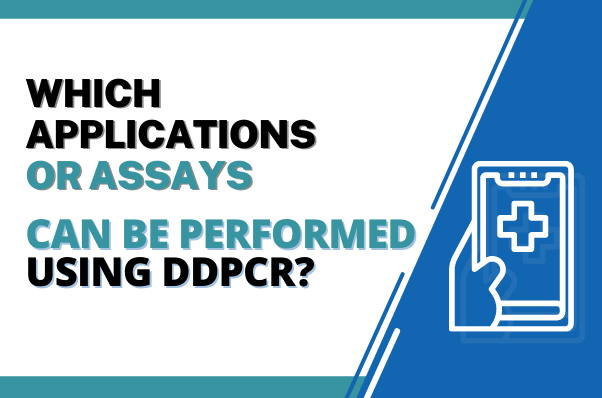Instead of the relative quantification of real-time polymerase chain reaction (qPCR), droplet digital PCR (ddPCR) ensures absolute quantification – an effortless determination of the number of target sequences in the original sample without the use of standard curves or extrapolation. It is evident how this type of measurement is a good fit for a wide range of applications that were previously unattainable.
ddPCR is based on massive partitioning through droplet generation. A sample volume of 20 µl is partitioned into thousands of droplets (around twenty thousand), each containing one target nucleic acid sequence, a few of them, or no target sequences at all. At the end of the amplification process (aided by primers), every droplet passes through a droplet reader. It counts the number of positive droplets (those that contain the target sequence) and negative droplets (those that don’t). Based on the droplet count and the fraction of positive droplets, a ddPCR system can easily calculate the concentration of target templates at the beginning of the experiment.
Given how precise, accurate, sensitive, and straightforward the ddPCR process is, which applications or assays can be performed using it?
ddPCR Applications
Real-time PCR cannot be used as a diagnostic standard because it delivers low positive and occasionally even false-positive results in clinical samples. Ever since the commercialization of ddPCR in 2011, scientists have been trying to find ways to introduce it into clinical practice.
As of yet, ddPCR is extremely efficient in the following areas:
- Determining copy number variation
Copy number variation (CNV) describes the presence of variable numbers of copies of a specific DNA segment in relation to a reference genome. Copy number changes can be the result of deletions or duplications. In some cases, there can be hundreds of copy number differences between individuals of the same species, but most commonly, the number of differences is much smaller.
ddPCR enables high-throughput screening of CNV. A ddPCR system can easily detect fold changes as small as 1.2-fold in copy number variation from five to six copies. Furthermore, a ddPCR system is flexible enough that one or multiple colors can be used for detection. An EvaGreen assay (single-color) reduces the cost of the experiment.
Digital droplet PCR can determine CNV related to biomarkers of various diseases, such as cancer and neurological disease. CNV is also important in population and lineage, and plant genome studies.
- Measuring levels of gene expression
Studying gene expression is significant in providing insights into normal cellular processes (for example, differentiation) but also into abnormal or pathological processes. Gene expression is mainly defined as the study of gene transcription to synthesize functional gene products (protein products or functional RNA).
ddPCR is particularly effective in detecting small fold differences in gene expression, such as 2-fold or lower. It can also detect targets that are present in low abundance or samples rich in PCR inhibitors. Unlike qPCR methods, droplet digital polymerase chain reaction is not as sensitive to PCR inhibitors.
- Next-generation sequencing (NGS)
NGS is also known as massively parallel or deep sequencing. It is a technique that allows for the entire human genome to be sequenced in a single day. That’s millions of nucleotide sequences being deciphered simultaneously. NGS’s scalability, speed, and ultra-high throughput make it an invaluable tool in medicine, oncology, genomics, evolutionary biology, forensic sciences, and transcriptomics.
The role of ddPCR in NGS is that of increasing the accuracy of the sequencing process and reducing run repeats by measuring NGS sample library preparations. Additionally, ddPCR can be utilized to validate the sequencing results, such as polymorphisms of a single nucleotide.
- Detecting rare DNA target copies
A rare mutation is a nucleotide sequence that is present at a very low frequency in a wild-type population. Rare mutation detection (RMD) is the process of identifying these rare mutations, which is especially important in analyzing cancer biopsy samples. The biggest obstacle in RMD is the discrimination between two genomic sequences that are highly similar – the rare mutation and the wild-type sequences present in abundance.
ddPCR is a highly sensitive method, with a quantification precision of ±10%. It has an excellent signal-to-noise ratio which enables ddPCR systems to identify and quantify rare targets successfully. In positive droplets at the end of the experiment, the target DNA concentration is high while the background is diluted, allowing for accurate readings.
- Single-cell analysis
Single-cell analysis is used to study different cell types within the same tissue type or population, and the differences in cellular responses to stimuli. One cell has a small amount of nucleic acid, making the use of qPCR in this type of analysis rather challenging. In comparison, ddPCR’s higher sensitivity and absolute quantification allow a simple analysis of cell-cell variations.
Moreover, ddPCR is useful for generating a single-cell library for further analysis by other techniques, such as NGS.
- Detecting genome edits
Practically any cell’s genome can be specifically modified thanks to genome editing. However, gene edits are often low in frequency (less than 5%), especially in the case of primary or induced pluripotent stem cells. This low frequency hinders reliable detection of edits by sequencing- or gel-based methods. Alternatively, it requires clonal isolation of edited cells, which is a laborious process.
The ddPCR-based method for detecting NHEJ and HDR alleles generated by editing systems such as TALEN and CRISPR/Cas9 are cost-efficient and ultra-sensitive compared to alternatives.
ddPCR in Immunology
This type of PCR has found its application in immunology and infectious disease diagnosis. It can detect several different pathogens causing communicable diseases, including:
- Plasmodium parasites that cause malaria
- Mycobacterium tuberculosis
- Staphylococcus, Listeria, and Salmonella
- Hepatitis B virus (HBV)
- Human immunodeficiency virus (HIV)
- Equine herpesvirus 1 and 4 that cause herpes in horses
ddPCR is more suitable for clinical practice than qPCR and provides far quicker results than serological tests or pathogen culturing. It also enables easier sampling in diseases that were difficult to diagnose in the past, such as extrapulmonary tuberculosis. ddPCR has most recently shown remarkable performance in SARS-CoV-2 detection.
ddPCR in Oncology
ddPCR has two primary uses in oncology:
- Liquid biopsy analysis – Liquid biopsy is a less invasive procedure than standard tumor biopsies. It includes sampling body fluids from a patient, such as blood, cerebrospinal fluid, tears, saliva, urine, etc. ddPCR is an excellent fit for analyzing liquid biopsies and is becoming irreplaceable in predicting, diagnosing, and monitoring a range of cancer types.
- Archival tumor tissues analysis – Archival tumor tissue is invaluable in cancer research as it represents a source for biomarker testing that is easily accessible. Because archival tissue has a limited amount of DNA and can be of poor quality, ddPCR is a valuable tool in this type of analysis.
ddPCR Assays
A variety of ddPCR assays is available based on the above-mentioned applications. Commercial ddPCR assay selection includes:
- Cell and gene therapy
- Genome edit detection
- Gene expression
- Copy number variation
- Mutation detection
Of course, if your project requires additional assays, MOgene offers ddPCR assay design and optimization to fit your needs.
Conclusion
The practicality, efficiency, and sensitive detection of ddPCR in various studies are proven time and again. Even though qPCR is still a good analytical tool for certain applications, ddPCR is an excellent option for:
- Next-generation sequencing
- Detecting rare nucleic acid targets
- Determining copy number variation
- Single-cell analysis
- Measuring levels of gene expression
- Detecting genome edits
Droplet digital PCR technology has a significant role in diagnosing infectious diseases such as malaria, tuberculosis, hepatitis B, AIDS, etc. It is regularly used in analyzing liquid biopsy samples to describe the heterogeneity inside a tumor and monitor the tumor changes that occur in response to treatment.
Is your institution in need of ddPCR services? We would be happy to help with any projects you might have in plan. Contact us at MOgene so we can discuss the best way to implement ddPCR in your research.

